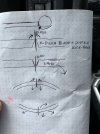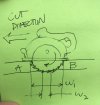What is the best way to crosscut a long piece (~12 ft) of rough lumber in half with a circular saw?
Normally when I am cutting off smaller pieces I always keep the larger section supported by two sawhorses or a workbench and let the smaller unsupported offcut drop free. If I am at a workbench I can sometimes contrive that the keeper part is supported by 2 blocks so the offcut only drops a couple inches too.
When it gets to cutting a 12ft board into 6ft halves outside I always worry about the much heavier weight of the offcut:
I have to do this occasionally, mostly to fit things in my car for transport, but not often enough to experiment a lot.
Normally when I am cutting off smaller pieces I always keep the larger section supported by two sawhorses or a workbench and let the smaller unsupported offcut drop free. If I am at a workbench I can sometimes contrive that the keeper part is supported by 2 blocks so the offcut only drops a couple inches too.
When it gets to cutting a 12ft board into 6ft halves outside I always worry about the much heavier weight of the offcut:
- Heavier offcut = offcut might start drooping when cut is nearly done due to weight on small remaining uncut portion = possible blade pinch potential?
- Heavier offcut = more tendency for the last portion of the wood to break under weight instead of cut = splintered corner on one or both sides
- Heavier offcut = more momentum = if it drops onto pavement or concrete, much more damaged corners (can be avoided sometimes by dropping onto dirt or grass)
I have to do this occasionally, mostly to fit things in my car for transport, but not often enough to experiment a lot.


